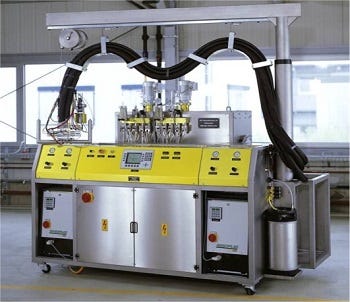JEC Show: Mahr, BASF to showcase thermoplastic RTM technology
Machinery manufacturer Mahr Metering Systems (Göttingen, Germany) and BASF (Ludwigshafen, Germany) have for some time been jointly developing material and system solutions for the T-RTM (thermoplastic resin transfer molding) process.
February 28, 2014
Machinery manufacturer Mahr Metering Systems (Göttingen, Germany) and BASF (Ludwigshafen, Germany) have for some time been jointly developing material and system solutions for the T-RTM (thermoplastic resin transfer molding) process. At upcoming the JEC Europe Show in Paris to be held March 11-13, Mahr (Hall 7.3, Booth R 35) will be exhibiting an initial prototype of a self-cleaning mixing head that is part of a machine concept for processing reactive polyamide by means of inexpensive low-pressure RTM technology. The goal is to develop a robust and automatic system with short cycle times that is suitable for high-volume production.
|
Fraunhofer ICT's T-RTM equipment incorporates a dosing unit for two or three reactive components. |
Simultaneously, BASF (Hall 7.2, Booth F 51) has been optimizing its first reactive polyamide (PA) systems for these economically relevant, fast production cycles. These are two-component systems based on the precursor caprolactam monomer, an appropriate additive system and fibers with compatible sizings. What is special about these systems is their low viscosity and long flow paths compared to other reactive resins, making them especially suitable for low-pressure RTM technology. Through this joint effort, the two companies hope to facilitate the introduction of anionic polymerizing PA 6 to the market - for future volume production of structural thermoplastic composite components.
Others investigating the application of T-RTM include the Fraunhofer-Institut für Chemische Technologie ICT (Pfinztal, Germany). Continuous fiber reinforcement based on glass, carbon and aramid fibers are being combined with in-situ-polymerizing matrix systems such as cast polyamides (cast PA6 and cast PA12) and cyclo-butylene terephthalate (CBT) to manufacture parts with fiber volume content of up to 60% while maintaining good impact properties.
About the Author(s)
You May Also Like



